Daily Precipitation Changes over Large River Basins in China, 1960–2013
Abstract
:1. Introduction
2. Data and Methodology
2.1. Data and Pre-Processing
2.1.1. Quality Control
2.1.2. Data Homogeneity
2.1.3. Missing Values
2.2. Methodology
2.2.1. Trends Detection
2.2.2. Spatial Interpolation
3. Results and Analysis
3.1. Annual Character of Precipitation Tendencies
3.2. Seasonal Characteristics of Precipitation Tendencies
3.2.1. Seasonal Precipitation
3.2.2. Seasonal Distribution
4. Discussion and Conclusion
Acknowledgments
Author Contributions
Conflicts of Interest
References
- Liu, B.; Xu, M.; Henderson, M.; Qi, Y. Observed trends of precipitation amount, frequency, and intensity in China, 1960–2000. J. Geophys. Res. Atmos. 2005, 110. [Google Scholar] [CrossRef]
- Rodrigo, F.S.; Trigo, R.M. Trends in daily rainfall in the Iberian Peninsula from 1951 to 2002. Int. J. Climatol. 2007, 27, 513–529. [Google Scholar] [CrossRef]
- Field, C.B.; Van Aalst, M. Freshwater resource. In Climate Change 2014: Impacts, Adaptation, and Vulnerability. Part A: Global and Sectoral Aspects; Cambridge University Press: Cambridge, UK; New York, NY, USA, 2014; Volume 1. [Google Scholar]
- Hulme, M.; Osborn, T.J.; Johns, T.C. Precipitation sensitivity to global warming: Comparison of observations with HadCM2 simulations. Geophys Res. Lett. 1998, 25, 3379–3382. [Google Scholar] [CrossRef]
- Karl, T.R.; Knight, R.W. Secular Trends of Precipitation Amount, Frequency, and Intensity in the United States. Bull. Am. Meteorol. Soc. 1998, 79, 231–241. [Google Scholar] [CrossRef]
- Brunetti, M.; Maugeri, M.; Monti, F.; Nanni, T. Changes in daily precipitation frequency and distribution in Italy over the last 120 years. J. Geophys. Res. Atmos. 2004, 109. [Google Scholar] [CrossRef]
- Wu, Y.; Wu, S.Y.; Wen, J.; Xu, M.; Tan, J. Changing characteristics of precipitation in China during 1960–2012. Int. J. Climatol. 2015, 36, 1387–1402. [Google Scholar] [CrossRef]
- Karl, T.R.; Knight, R.W.; Plummer, N. Trends in high-frequency climate variability in the twentieth century. Nature 1995, 377, 217–220. [Google Scholar] [CrossRef]
- Zinke, P.J. Forest interception studies in the United States. In International Symposium on Forest Hydrology; Pergamon Press: New York, NY, USA, 1967; pp. 137–161. [Google Scholar]
- Li, W.; Zhai, P.; Cai, J. Research on the Relationship of ENSO and the Frequency of Extreme Precipitation Events in China. Adv. Clim. Chang. Res. 2011, 2, 101–107. [Google Scholar] [CrossRef]
- Zhang, X.; Cong, Z. Trends of precipitation intensity and frequency in hydrological regions of China from 1956 to 2005. Glob. Planet Chang. 2014, 117, 40–51. [Google Scholar] [CrossRef]
- Chen, Y.; Chen, X.; Ren, G. Variation of extreme precipitation over large river basins in China. Adv. Clim. Chang. Res. 2011, 2, 108–114. [Google Scholar] [CrossRef]
- Su, B.D.; Jiang, T.; Jin, W.B. Recent trends in observed temperature and precipitation extremes in the Yangtze River basin, China. Theor. Appl. Climatol. 2006, 83, 139–151. [Google Scholar] [CrossRef]
- Zhang, Q.; Xu, C.; Gemmer, M.; Chen, Y.D.; Liu, C. Changing properties of precipitation concentration in the Pearl River basin, China. Stoch. Environ. Res. Risk Assess. 2009, 23, 377–385. [Google Scholar] [CrossRef]
- Yang, T.; Shao, Q.; Hao, Z.; Chen, X.; Zhang, Z.; Xu, C.; Sun, L. Regional frequency analysis and spatio-temporal pattern characterization of rainfall extremes in the Pearl River Basin, China. J. Hydrol. 2010, 380, 386–405. [Google Scholar] [CrossRef]
- Shi, W.; Yu, X.; Liao, W.; Wang, Y.; Jia, B. Spatial and temporal variability of daily precipitation concentration in the Lancang River basin, China. J. Hydrol. 2013, 495, 197–207. [Google Scholar] [CrossRef]
- Hu, Y.; Maskey, S.; Uhlenbrook, S. Trends in temperature and rainfall extremes in the Yellow River source region, China. Clim. Chang. 2012, 110, 403–429. [Google Scholar] [CrossRef]
- Vincent, L.A.; Zhang, X.; Bonsal, B.R.; Hogg, W.D. Homogenization of daily temperatures over Canada. J. Clim. 2002, 15, 1322–1334. [Google Scholar] [CrossRef]
- Liu, W.; Fu, G.; Liu, C.; Charles, S.P. A comparison of three multi-site statistical downscaling models for daily rainfall in the North China Plain. Theor. Appl. Climatol. 2013, 111, 585–600. [Google Scholar] [CrossRef]
- Xu, X.; Du, Y.; Tang, J.; Wang, Y. Variations of temperature and precipitation extremes in recent two decades over China. Atmos. Res. 2011, 101, 143–154. [Google Scholar] [CrossRef]
- Gong, D.; Shi, P.; Wang, J. Daily precipitation changes in the semi-arid region over northern China. J. Arid Environ. 2004, 59, 771–784. [Google Scholar] [CrossRef]
- Feng, S.; Hu, Q.; Qian, W. Quality control of daily meteorological data in China, 1951–2000: a new dataset. Int. J. Climatol. 2004, 24, 853–870. [Google Scholar] [CrossRef]
- Mao-chang, C.; Hai, Z.; Shu-min, L.; Arpe, K.; Dumenil, L. Variability of daily precipitation in China (1980–1993): PCA and wavelet analysis of observation and ECMWF reanalysis data. Chin. J. Oceanol. Limnol. 2000, 18, 117–125. [Google Scholar] [CrossRef]
- Svensson, C. Empirical orthogonal function analysis of daily rainfall in the upper reaches of the Huai River basin, China. Theor. Appl. Climatol. 1999, 62, 147–161. [Google Scholar] [CrossRef]
- Qian, W.; Lin, X. Regional trends in recent precipitation indices in China. Meteorol. Atmos. Phys. 2005, 90, 193–207. [Google Scholar] [CrossRef]
- Easterling, D.R.; Evans, J.L.; Groisman, P.Y.; Karl, T.R.; Kunkel, K.E.; Ambenje, P. Observed variability and trends in extreme climate events: A brief review. Bull. Am. Meteorol. Soc. 2000, 81, 417–425. [Google Scholar] [CrossRef]
- Vicente Serrano, S.M.; Beguería, S.; López Moreno, J.I.; García Vera, M.A.; Stepanek, P. A complete daily precipitation database for northeast Spain: Reconstruction, quality control, and homogeneity. Int. J. Climatol. 2010, 30, 1146–1163. [Google Scholar] [CrossRef] [Green Version]
- Brunetti, M.; Maugeri, M.; Monti, F.; Nanni, T. Temperature and precipitation variability in Italy in the last two centuries from homogenised instrumental time series. Int. J. Climatol. 2006, 26, 345–381. [Google Scholar] [CrossRef]
- Wijngaard, J.B.; Klein Tank, A.; Können, G.P. Homogeneity of 20th century European daily temperature and precipitation series. Int. J. Climatol. 2003, 23, 679–692. [Google Scholar] [CrossRef]
- Peterson, T.C.; Easterling, D.R.; Karl, T.R.; Groisman, P.; Nicholls, N.; Plummer, N.; Torok, S.; Auer, I.; Boehm, R.; Gullett, D. Homogeneity adjustments of in situ atmospheric climate data: A review. Int. J. Climatol. 1998, 18, 1493–1517. [Google Scholar] [CrossRef]
- Vincent, L.A. A technique for the identification of inhomogeneities in Canadian temperature series. J. Clim. 1998, 11, 1094–1104. [Google Scholar] [CrossRef]
- Alexandersson, H.; Moberg, A. Homogenization of Swedish temperature data. Part I: Homogeneity test for linear trends. Int. J. Climatol. 1997, 17, 25–34. [Google Scholar] [CrossRef]
- Szentimrey, T. Statistical procedure for joint homogenization of climatic time series. In Proceedings of the 1st Seminar of Homogenisation of Surface Climatological Data, Budapest, Hungary, 6–12 October 1996; pp. 47–62.
- Potter, K.W. Illustration of a new test for detecting a shift in mean in precipitation series. Mon. Weather Rev. 1981, 109, 2040–2045. [Google Scholar] [CrossRef]
- Moberg, A.; Bergström, H. Homogenization of Swedish temperature data. Part III: The long temperature records from Uppsala and Stockholm. Int. J. Climatol. 1997, 17, 667–699. [Google Scholar] [CrossRef]
- Vincent, L.A.; Mekis, E. Changes in daily and extreme temperature and precipitation indices for Canada over the twentieth century. Atmosphere-Ocean 2006, 44, 177–193. [Google Scholar] [CrossRef]
- Kumar, S.; Merwade, V.; Kam, J.; Thurner, K. Streamflow trends in Indiana: Effects of long term persistence, precipitation and subsurface drains. J. Hydrol. 2009, 374, 171–183. [Google Scholar] [CrossRef]
- Yue, S.; Pilon, P.; Phinney, B.; Cavadias, G. The influence of autocorrelation on the ability to detect trend in hydrological series. Hydrol. Process. 2002, 16, 1807–1829. [Google Scholar] [CrossRef]
- Khattak, M.S.; Babel, M.S.; Sharif, M. Hydro-meteorological trends in the upper Indus River basin in Pakistan. Clim. Res. 2011, 46, 103–119. [Google Scholar] [CrossRef]
- Sen, P.K. Estimates of the regression coefficient based on Kendall's tau. J. Am. Stat. Assoc. 1968, 63, 1379–1389. [Google Scholar] [CrossRef]
- Bargaoui, Z.K.; Chebbi, A. Comparison of two kriging interpolation methods applied to spatiotemporal rainfall. J. Hydrol. 2009, 365, 56–73. [Google Scholar] [CrossRef]
- Zhai, P.; Zhang, X.; Wan, H.; Pan, X. Trends in total precipitation and frequency of daily precipitation extremes over China. J. Clim. 2005, 18, 1096–1108. [Google Scholar] [CrossRef]
- Wang, H.; Gao, J.E.; Zhang, M.; Li, X.; Zhang, S.; Jia, L. Effects of rainfall intensity on groundwater recharge based on simulated rainfall experiments and a groundwater flow model. Catena 2015, 127, 80–91. [Google Scholar] [CrossRef]
- Wang, Y.; Zhou, L. Observed trends in extreme precipitation events in China during 1961–2001 and the associated changes in large-scale circulation. Geophys. Res. Lett. 2005, 32. [Google Scholar] [CrossRef]
- Liu, H.; Lei, T.W.; Zhao, J.; Yuan, C.P.; Fan, Y.T.; Qu, L.Q. Effects of rainfall intensity and antecedent soil water content on soil infiltrability under rainfall conditions using the run off-on-out method. J. Hydrol. 2011, 396, 24–32. [Google Scholar] [CrossRef]
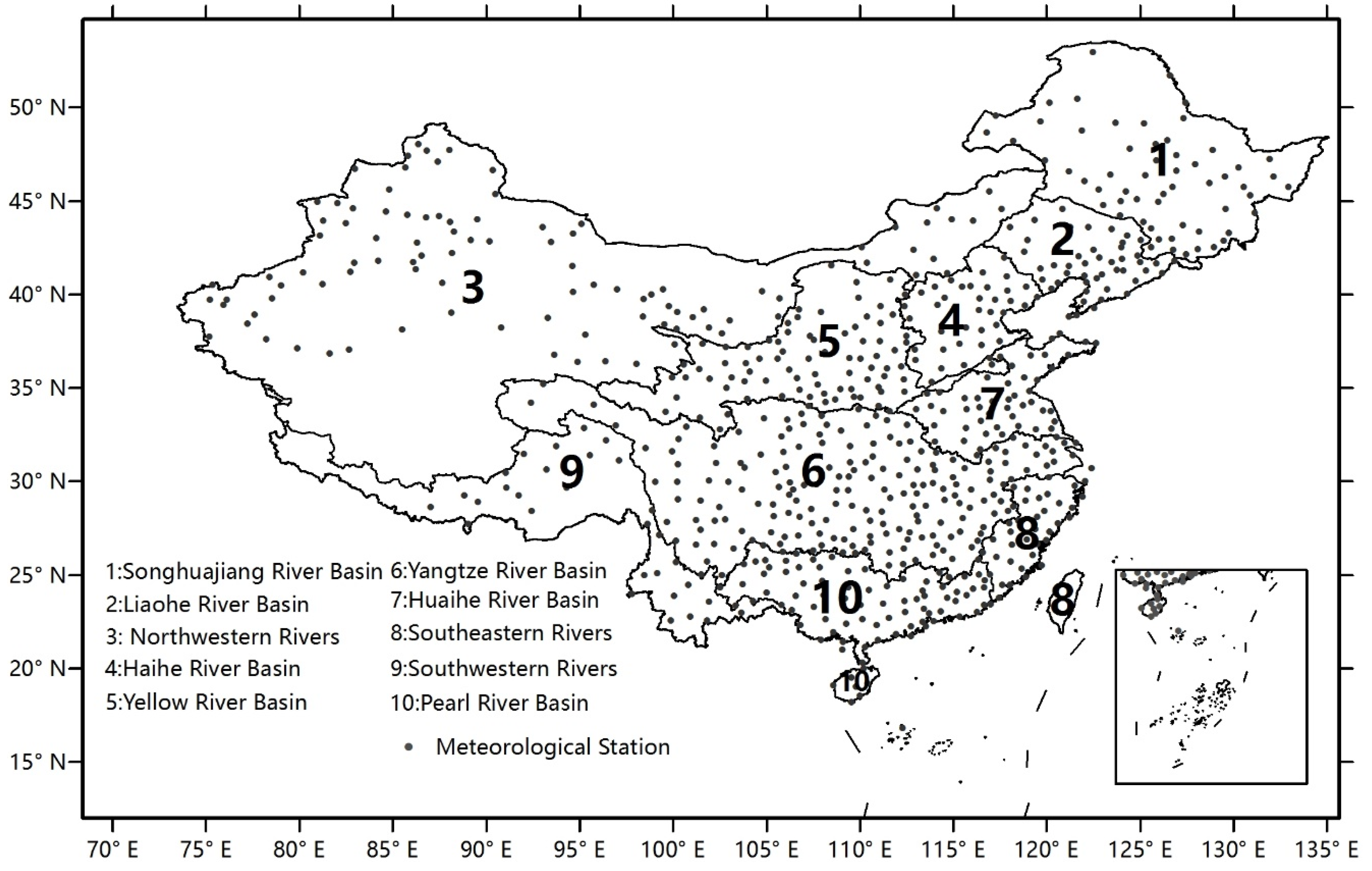
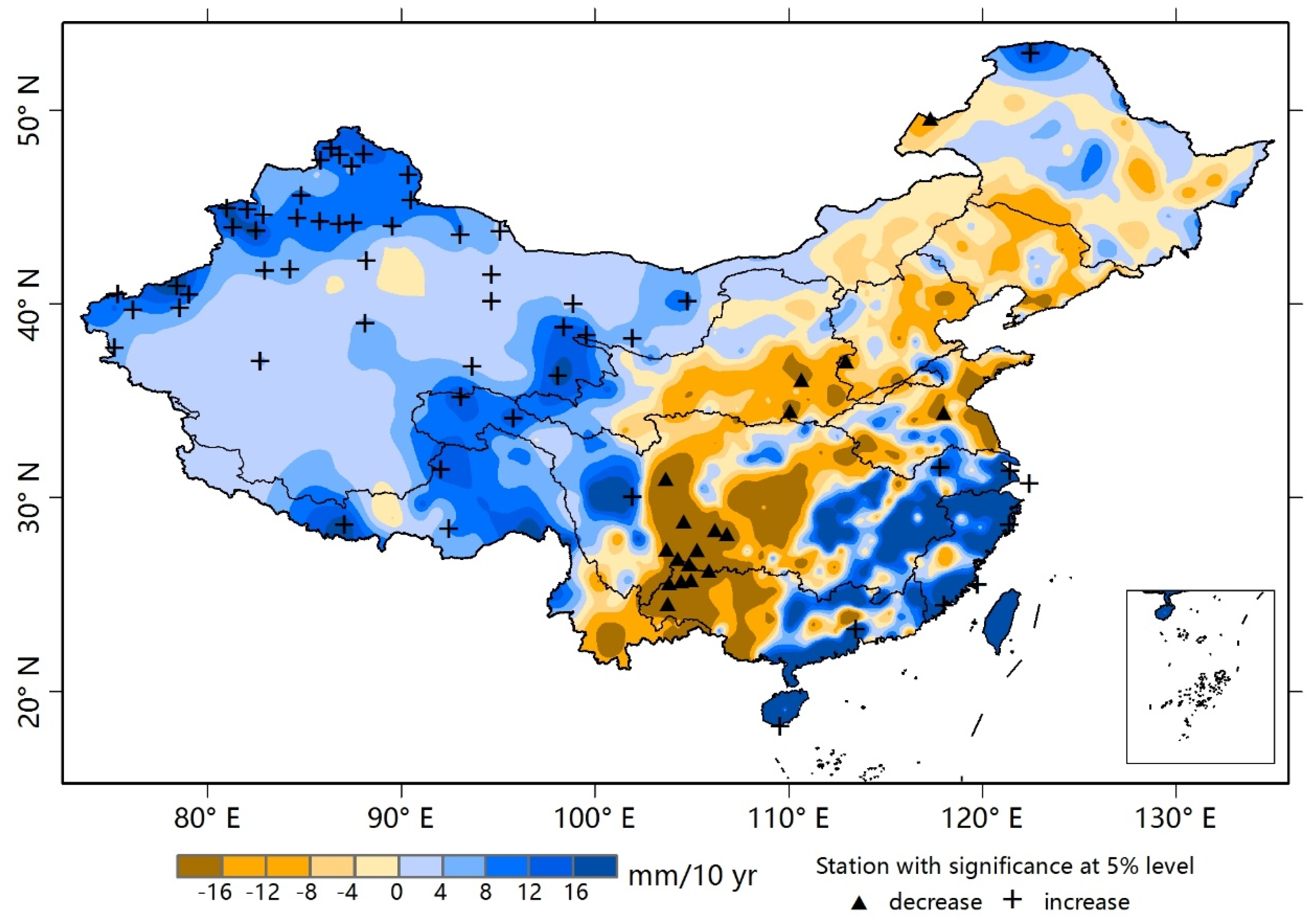

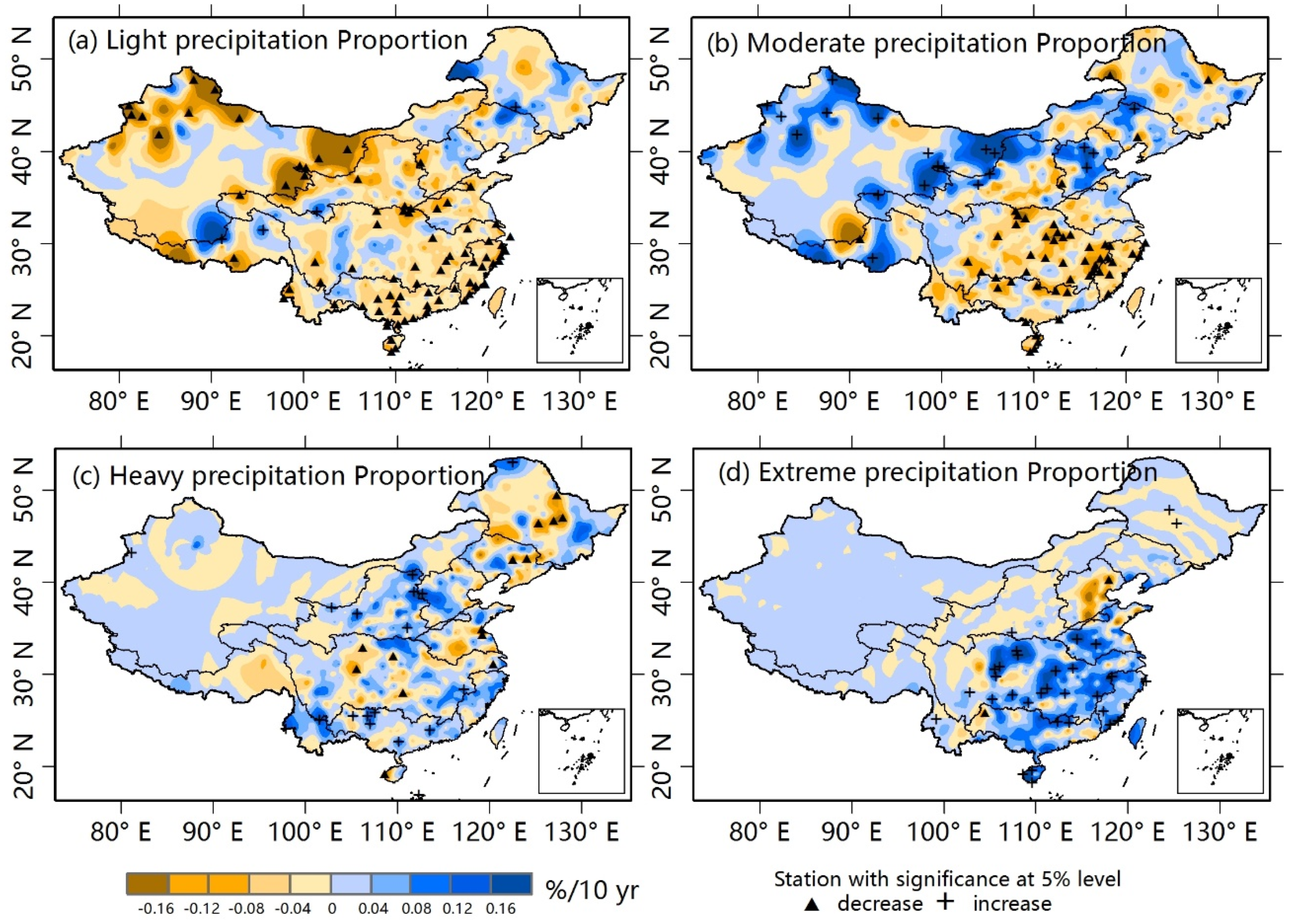
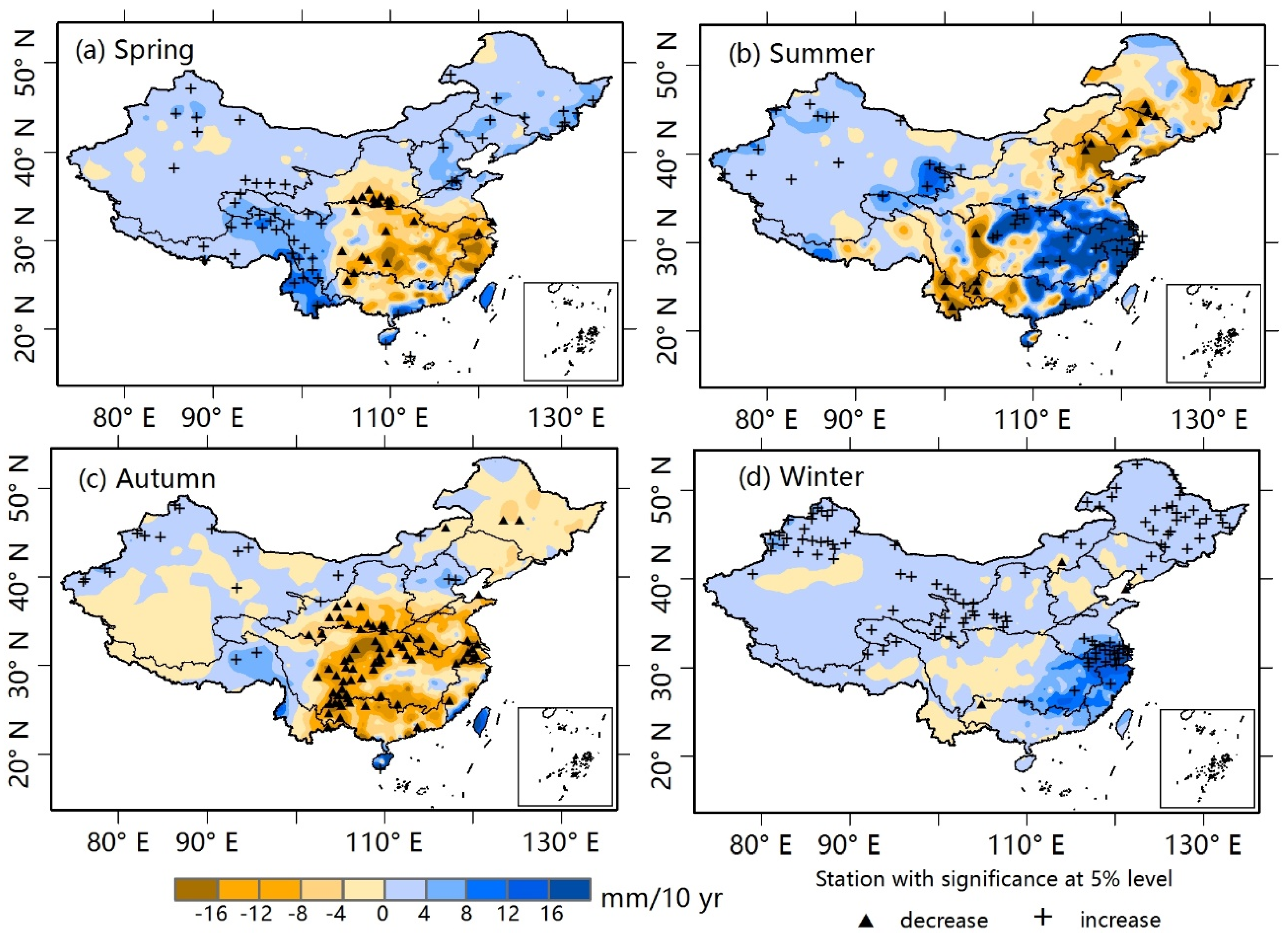
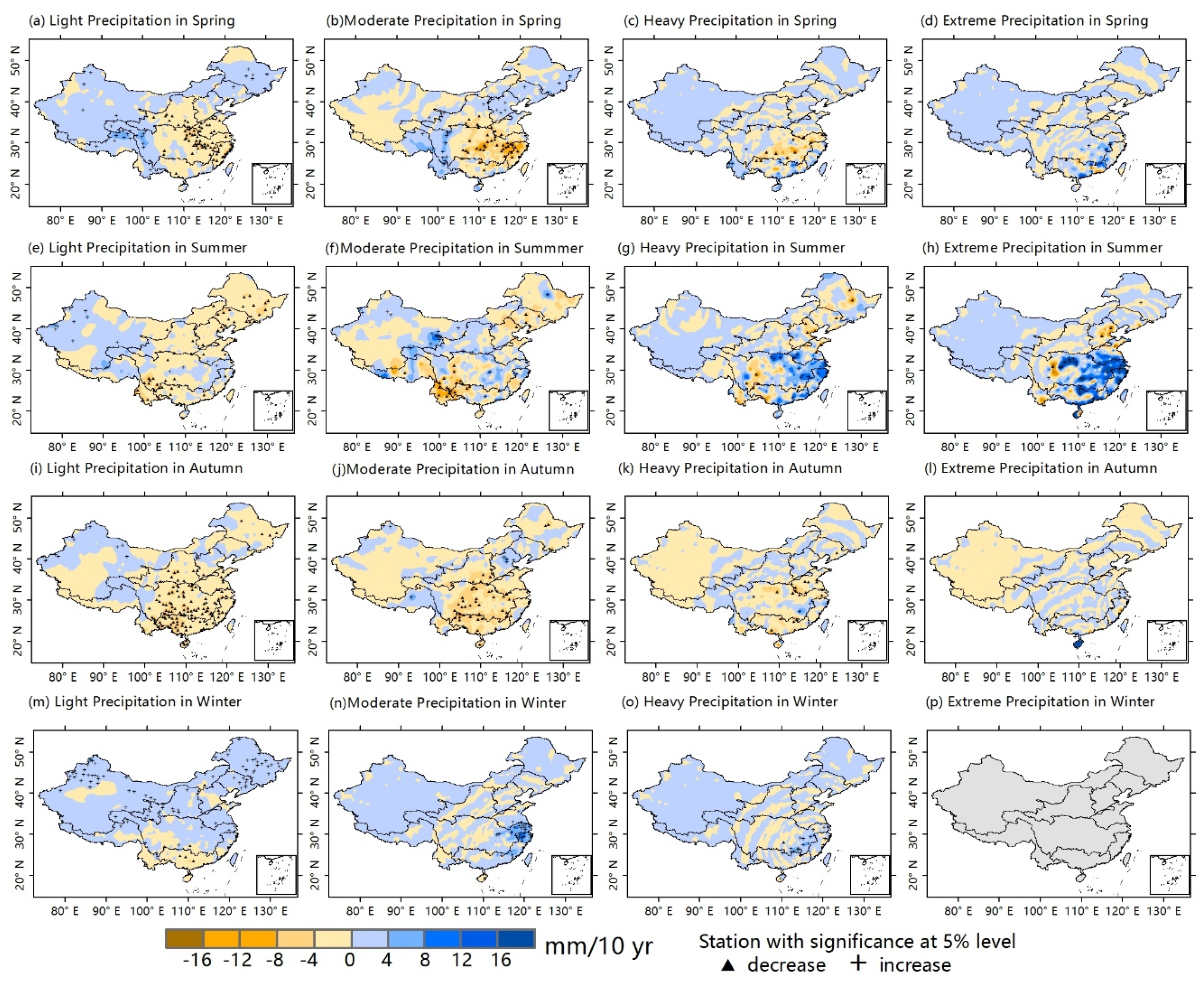
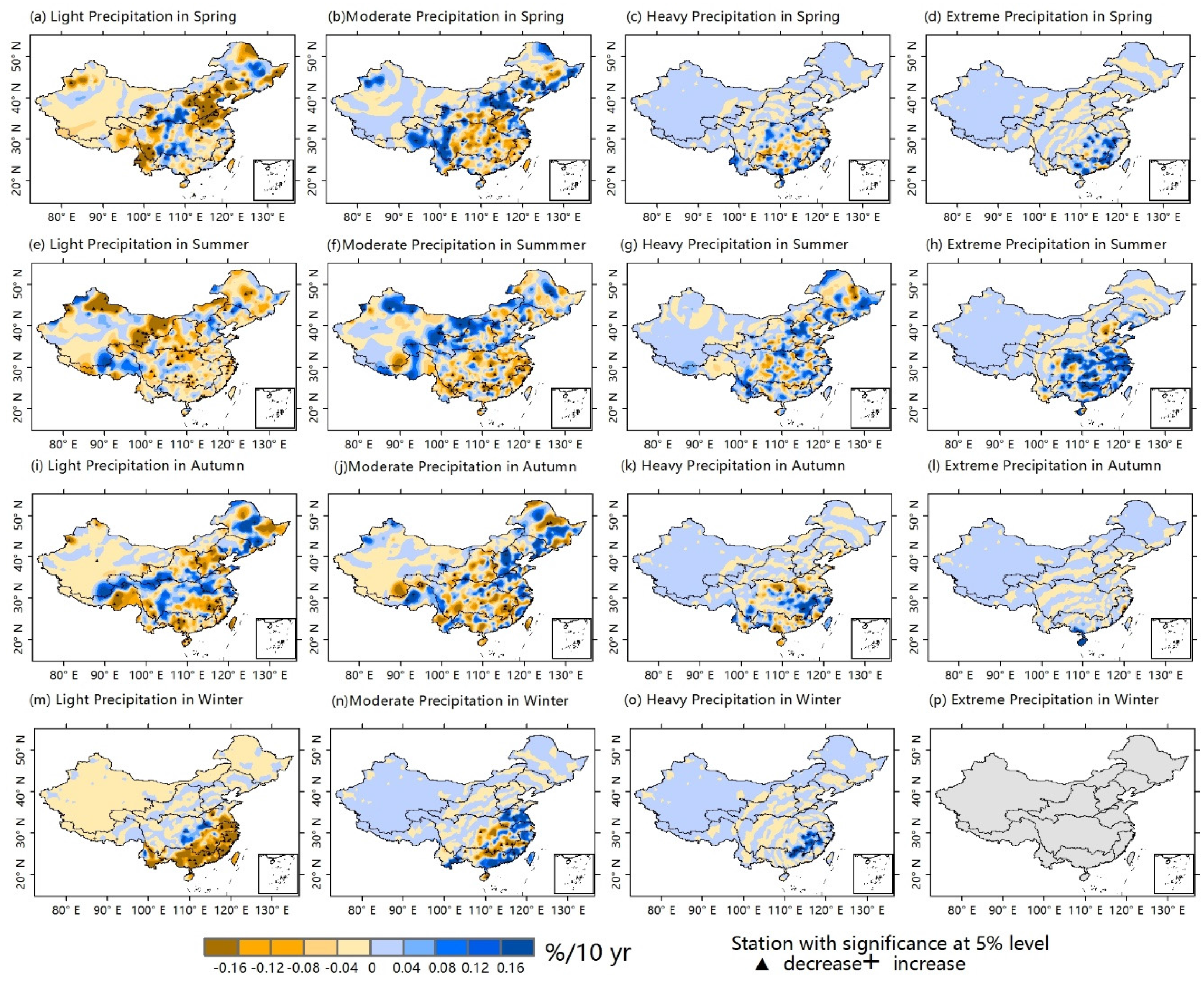
| Basin | Amount (mm/10yr) | Proportion (%/10yr) | |||||||
|---|---|---|---|---|---|---|---|---|---|
| Light Rain | Moderate Rain | Heavy Rain | Extreme Rain | Total | Light Rain | Moderate Rain | Heavy Rain | Extreme Rain | |
| Songhuajiang River | −0.01 | −1.65 | −0.57 | 0.20 | −2.89 | 0.25 | −0.10 | −0.06 | 0.00 |
| Liaohe River | −1.68 | −1.48 | −1.80 | −2.48 | −8.60 | 0.13 | 0.12 | 0.05 | −0.29 |
| Northwestern Rivers | 1.44a | 0.99a | 0.41 | 0.32 | 3.69a | −0.68a | 0.37b | 0.13 | 0.02 |
| Haihe River | −1.65 | 0.86 | −0.45 | −4.39b | −5.59 | −0.05 | 0.53b | 0.08 | −0.56b |
| Yellow River | −1.73 | −1.44 | 0.61 | −0.31 | −2.69 | −0.45 | 0.12 | 0.33b | −0.05 |
| Yangtze River | −2.28b | −3.30b | 0.61 | 3.88b | −1.13 | −0.22b | −0.28a | 0.08 | 0.45a |
| Huaihe River | −3.08a | −1.24 | −1.80 | −1.10 | −7.20 | −0.31a | −0.01 | 0.04 | 0.47 |
| Southeastern Rivers | −3.94 | −3.71 | 9.35b | 15.63a | 22.21 | −0.48a | −0.52 | 0.34a | 0.71a |
| Southwestern Rivers | 1.44 | 1.04 | 2.14 | 1.84b | 5.29 | −0.43a | 0.19 | 0.12 | 0.13a |
| Pearl River | −5.44a | −4.48 | 0.39 | 5.00 | −5.71 | −0.23a | −0.24a | 0.04 | 0.34b |
| All China | −0.41 | −0.65 | 0.47 | 1.76b | 1.10 | −0.39a | 0.06 | 0.15a | 0.15a |
| Basin | Spring | Summer | Autumn | Winter | Annual |
|---|---|---|---|---|---|
| Songhuajiang River | 2.03 | −4.90 | −2.16a | 1.33a | −2.89 |
| Liaohe River | 2.21 | −7.75 | −3.42 | 0.17 | −8.60 |
| Northwestern rivers | 0.97b | 1.36 | 0.33 | 0.75a | 3.69a |
| Haihe River | 4.91a | −12.53a | 1.85 | −0.18 | −5.59 |
| Yellow River | −0.62 | −0.84 | −3.38 | 0.34 | −2.69 |
| Yangtze River | −3.35 | 6.68b | −6.15a | 2.56 | −1.13 |
| Huaihe River | −1.48 | 3.30 | −7.60 | 1.86 | −7.20 |
| Southeastern rivers | −5.14 | 15.99b | 0.55 | 7.37a | 22.21 |
| Southwestern rivers | 5.72a | −2.70 | 0.59 | −0.09 | 5.29 |
| Pearl River | −4.27 | 0.94 | −9.47 | 2.11 | −5.71 |
| All China | 0.54 | 0.10 | −2.76 | 1.26 | 1.10 |
| Season | Intensity | Songhuajiang River | Liaohe River | Northwestern Rivers | Haihe River | Yellow River | Yangtze River | Huaihe River | Southeastern Rivers | Southwestern Rivers | Pearl River | All China |
|---|---|---|---|---|---|---|---|---|---|---|---|---|
| Spring | Light rain | 1.02b | 0.56 | 0.43b | 0.28 | −0.56 | −0.69 | −1.67a | −2.52a | 1.21a | −0.82 | 0.11 |
| Moderate rain | 0.84 | 1.29a | 0.31b | 1.93a | −0.11 | −1.95a | −0.87 | −5.89a | 1.93a | −1.71 | −0.15 | |
| Heavy rain | 0.03 | 0.35 | 0.13 | 1.15a | 0.16 | −1.53 | −0.20 | 0.05 | 1.34a | −1.28 | 0.02 | |
| Extreme rain | 0.11a | 0.08 | 0.15 | 0.28a | −0.02 | 0.40 | 0.95 | 2.66 | 0.89a | −0.66 | 0.36 | |
| Total | 2.03 | 2.21 | 0.97b | 4.91a | −0.62 | −3.35 | −1.48 | −5.14 | 5.72a | −4.27 | 0.54 | |
| Summer | Light rain | −2.21a | −2.28a | 0.23 | −1.58a | −0.56 | −0.23 | −0.74b | −0.23 | −0.36 | −1.22b | −0.57b |
| Moderate rain | −2.12 | −2.05b | 0.52b | −2.71b | 0.49 | 0.19 | 0.06 | −0.27 | −1.83 | −2.13 | −0.60 | |
| Heavy rain | −1.22 | −1.01 | 0.33 | −2.08 | −0.19 | 1.44 | 2.63 | 6.05a | −0.79 | 0.67 | 0.29 | |
| Extreme rain | 0.06 | −2.49 | 0.36 | −5.12b | −0.53 | 4.79a | 2.95 | 8.88b | 0.55 | 5.16 | 0.88b | |
| Total | −4.90 | −7.75 | 1.36 | −12.53a | −0.84 | 6.68b | 3.30 | 15.99b | −2.70 | 0.94 | 0.10 | |
| Autumn | Light rain | −0.53 | −0.48 | 0.20 | −0.17 | −1.46b | −1.95a | −1.81b | −1.42 | −0.19 | −3.55a | −0.86a |
| Moderate rain | −0.97 | −0.52 | −0.03 | 1.03 | −1.44 | −3.04a | −1.88 | −0.77 | 0.28 | −3.54a | −1.09a | |
| Heavy rain | −0.31 | −0.90 | 0.02 | 0.39 | 0.05 | −1.01 | −3.33b | 0.58 | 0.23 | −3.09 | −0.38 | |
| Extreme rain | −0.03 | −0.19 | 0.05 | 0.37 | −0.43b | −0.59 | −0.40 | 1.90 | 0.18 | 0.29 | −0.06 | |
| Total | −2.16 | −3.42 | 0.33 | 1.85 | −3.38 | −6.15a | −7.60 | 0.55 | 0.59 | −9.47 | −2.76a | |
| Winter | Light rain | 1.12a | 0.36 | 0.53a | 0.01 | 0.38b | 0.46 | 1.00 | 0.17 | −0.03 | −1.21 | 0.38b |
| Moderate rain | 0.18a | 0.03 | 0.05 | −0.01 | −0.01 | 0.63 | 1.11 | 3.75b | −0.10 | 1.00 | 0.27 | |
| Heavy rain | 0.05 | 0.00 | 0.03 | −0.01 | −0.01 | 1.15a | 0.04 | 3.08b | 0.24 | 1.93a | 0.44a | |
| Extreme rain | 0.00 | 0.00 | 0.02 | −0.01 | 0.00 | 0.09 | 0.00 | 0.52b | 0.01 | 0.55b | 0.09 | |
| Total | 1.33 | 0.17 | 0.75 | −0.18 | 0.34 | 2.56 | 1.86 | 7.37 | −0.09 | 2.11 | 1.26 |
| Season | Intensity | Songhuajiang River | Liaohe River | Northwestern Rivers | Haihe River | Yellow River | Yangtze River | Huaihe River | Southeastern Rivers | Southwestern Rivers | Pearl River | All China |
|---|---|---|---|---|---|---|---|---|---|---|---|---|
| Spring | Light rain | −0.28 | −1.93a | −0.51 | −3.00a | −0.58 | −0.13 | −1.35b | −0.49b | −1.17a | 0.14 | −0.59a |
| Moderate rain | 0.46 | 1.05b | 0.68a | 1.49a | 0.42 | 0.04 | −0.05 | −0.58a | 0.91a | −0.29 | 0.40a | |
| Heavy rain | −0.24 | 0.34 | 0.11 | 1.14a | 0.39 | −0.03 | 0.40 | 0.45b | 0.23b | 0.00 | 0.13b | |
| Extreme rain | 0.04a | 0.08 | 0.02 | 0.21a | 0.02 | 0.27 | 0.87a | 0.66b | 0.17b | 0.17 | 0.16a | |
| Summer | Light rain | −0.14 | −0.08 | −1.17a | 0.05 | −0.32 | −0.35a | −0.32b | −0.32a | −0.14 | −0.26b | −0.56a |
| Moderate rain | 0.03 | 0.17 | 0.76a | 0.19 | 0.41b | −0.29a | −0.31b | −0.61a | 0.14 | −0.42a | 0.30a | |
| Heavy rain | 0.04 | 0.24 | 0.14 | 0.22 | 0.13 | 0.08 | 0.13 | 0.28 | 0.05 | 0.05 | 0.16a | |
| Extreme rain | 0.08 | −0.28 | 0.09 | −0.47 | −0.11 | 0.54a | 0.58 | 0.64 | 0.14b | 0.65b | 0.15b | |
| Autumn | Light rain | 0.29 | 0.60 | −0.52 | −0.97 | −0.09 | 0.06 | 0.33 | −0.77b | −0.67b | −0.26 | −0.16 |
| Moderate rain | −0.38 | 0.14 | 0.23 | 0.98b | −0.15 | −0.27 | 0.44 | −0.12 | 0.48b | −0.06 | 0.05 | |
| Heavy rain | −0.14 | −0.18 | 0.02 | 0.43 | 0.59b | 0.13 | −1.07a | 0.17 | 0.07 | −0.34 | 0.06 | |
| Extreme rain | −0.03 | −0.06 | 0.05 | 0.22 | −0.17 | 0.14 | −0.04 | 0.66 | 0.06 | 0.42 | 0.09 | |
| Winter | Light rain | −0.36a | 0.44 | 0.55 | −0.03 | −0.10 | −0.24 | −1.07 | −1.88a | 1.10b | −1.95b | −0.16 |
| Moderate rain | 0.29a | 0.12 | 0.14b | 0.03 | 0.11 | −0.19 | 1.66b | 0.58 | 0.10 | 0.18 | 0.14 | |
| Heavy rain | 0.03 | 0.00 | 0.05 | −0.02 | 0.00 | 0.35a | 0.10 | 1.21b | 0.12 | 1.19a | 0.20a | |
| Extreme rain | 0.00 | 0.00 | 0.01 | 0.00 | 0.00 | 0.02 | 0.00 | 0.21 | 0.01 | 0.29a | 0.03 |
© 2016 by the authors; licensee MDPI, Basel, Switzerland. This article is an open access article distributed under the terms and conditions of the Creative Commons Attribution (CC-BY) license (http://creativecommons.org/licenses/by/4.0/).
Share and Cite
Qu, B.; Lv, A.; Jia, S.; Zhu, W. Daily Precipitation Changes over Large River Basins in China, 1960–2013. Water 2016, 8, 185. https://doi.org/10.3390/w8050185
Qu B, Lv A, Jia S, Zhu W. Daily Precipitation Changes over Large River Basins in China, 1960–2013. Water. 2016; 8(5):185. https://doi.org/10.3390/w8050185
Chicago/Turabian StyleQu, Bo, Aifeng Lv, Shaofeng Jia, and Wenbin Zhu. 2016. "Daily Precipitation Changes over Large River Basins in China, 1960–2013" Water 8, no. 5: 185. https://doi.org/10.3390/w8050185






